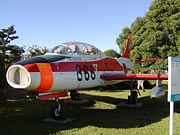| T-1 | |
|---|---|
| T-1B in special paint scheme | |
| Role | Intermediate trainer aircraft |
| Manufacturer | Fuji Heavy Industries |
| Number built | 66 |

The Fuji T-1 was Japan's first jet-powered trainer aircraft. The first flight was in January 1958. A total of 66 T-1 planes were built.[1] It was retired in March 2006.[citation needed]
Design and development[]
The T-1 was the first indigenously designed Japanese jet aircraft to be developed since World War II. The T-1A was powered by the British-designed Bristol Siddeley Orpheus turbojet,[2] while the T-1B used the Ishikawajima-Harima J3 turbojet.[3]
Variants[]
Data from: Simpson 2001, p. 246
- T1F1 : Prototype.
- T-1A (T1F1) : Powered by a 17.79 kN (4,000 lbf) Bristol Siddeley Orpheus Mk 805 turbojet engine. The original designation was T1F2. 46 built.
- T-1B (T1F2) : Powered by a 11.77 kN (2,645 lbf) Ishikawajima-Harima J3-IHI-3 turbojet engine. 20 built.
- T-1C : Converted to 13.72 kN (3,085 lbf) Ishikawajima-Harima J3-IHI-7 engines.
Operators[]
Specifications (T-1A)[]
Data from Jane's All The World's Aircraft 1965-66[4]
General characteristics
- Crew: 2
- Length: 12.12 m (39 ft 9 in)
- Wingspan: 10.50 m (34 ft 5 in)
- Height: 4.08 m (13 ft 5 in)
- Wing area: 22.22 m2 (239.2 sq ft)
- Aspect ratio: 4.96:1
- Airfoil: K-561/K-569
- Empty weight: 2,420 kg (5,335 lb)
- Gross weight: 4,150 kg (9,149 lb) clean
- Max takeoff weight: 5,000 kg (11,023 lb) (with external tanks)
- Fuel capacity: 1,400 L (308 Imp Gallons)
- Powerplant: 1 × Bristol Siddeley Orpheus Mk 805 turbojet, 18 kN (4,000 lbf) thrust
Performance
- Maximum speed: 925 km/h (575 mph; 499 kn) at 6,100 m (20,000 ft)
- Cruising speed: 620 km/h (385 mph; 335 kn) at 9,150 m (30,000 ft)
- Range: 1,300 km (808 mi; 702 nmi) (internal fuel)
- Ferry range: 1,950 km (1,212 mi; 1,053 nmi)
- Service ceiling: 14,400 m (47,244 ft) [5]
- Rate of climb: 33 m/s (6,500 ft/min)
Armament
- Guns: Provision for 1 × 12.7 mm Browning M53-2 machine gun in nose
- Hardpoints: 2 with provisions to carry combinations of:
- Missiles: 2 × AIM-9 Sidewinder air-to-air missiles
- Bombs: 2 × 340 kg (750 lb) bombs
- Other: 2 × 455 L (100 Imp Gallon) drop tanks
See also[]
References[]
- Citations
- ↑ Simpson 2001, p.246
- ↑ FUJI T-1 at faqs.org
- ↑ Odagiri, Hiroyuki (1996). Technology and Industrial Development in Japan. Clarendon Press, Oxford. pp. 224. ISBN 0-19-828802-6.
- ↑ Taylor 1965, p. 103.
- ↑ Donald and Lake 1996, p.175.
- Bibliography
- Donald, David and Jon Lake. Encyclopedia of World Military Aircraft. London:Aerospace Publishing, 1996, Single Volume Edition. ISBN 1-874023-95-6.
- Simpson, Rod (2001). Airlife's World Aircraft. Shrewsbury: Airlife Publishing Ltd. ISBN 1-84037-115-387.
- Taylor, John W. R. Jane's All The World's Aircraft 1965-66. London:Sampson Low, Marston, 1965.
External links[]
| Wikimedia Commons has media related to Fuji T-1. |
The original article can be found at Fuji T-1 and the edit history here.
